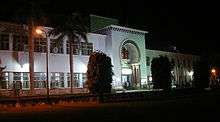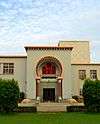Maulana Azad Library
 | |
| Established | 1875 (formally in 1877 as Lytton Library) |
|---|---|
| Location | Aligarh Muslim University, Aligarh |
| Branches | 100 |
| Collection | |
| Size | 1.4 million volumes |
| Access and use | |
| Circulation | 60565 |
| Population served | 28,000 students; 1,342 Faculty, 5,610 non-teaching staff |
| Other information | |
| Budget | 23.37 Million Rupees |
| Website | http://malibrary.amu.ac.in |
The Maulana Azad Library is the central library of Aligarh Muslim University in Aligarh, India. It is the second largest library in Asia.[1][2] The seven-storey building is surrounded by 4.75 acres (1.92 ha) of lawns and gardens. It has about 1,400,000 books. It celebrated Golden Jubilee on 7 December 2010.[3]
It got a donation of about 5000 books which were the personal collection of Kaifi Azmi.[4]
Dr. Nabi Hasan[5] serves as the current University Librarian of the library.[6]
History
Founding
The foundation of the Library was laid in 1877 at the time of establishment of the Mohammedan Anglo Oriental College by Lord Robert Bulwer-Lytton, 1st Earl of Lytton, the then Viceroy of India and it was named after him as Lytton Library. The present grand seven-storied building was inaugurated by Late Jawaharlal Nehru, the first Prime Minister of independent India in 1960 and the Library was named as Maulana Azad Library, after a great scholar, educationist, statesman, freedom fighter and the first Education Minister of the independent India.[7]
Controversy
In late 2014 the university's vice-chancellor Zameer Uddin Shah turned down a demand by female students of the college to be allowed to use the Maulana Azad Library, which was male-only. Shah stated that the issue was not one of discipline, but of space as if girls were allowed in the library there would be "four times more boys," putting a strain on the library's capacity.[8][9][10] Although there was a separate library for the university's Women's College, it was not as well-stocked as the Maulana Azad Library.[8] National human resource and development minister Smriti Irani decried Shah's defense as "an insult to daughters."[9]
Responding to a petition filed by a Human Rights Law Network intern, the Allahabad High Court ruled in November 2014 that the university's ban on female students from using the main library was unconstitutional, and that accommodations must be made to facilitate student use regardless of gender.[10][11] The High Court gave the university until 24 November 2014 to comply.[11]
Holdings

The library's collection includes about 1,400,000 books, along with periodicals, pamphlets, manuscripts, paintings and photographs. It aims at supporting students from all departments of the university.
The library has a sizeable collection of early printed books in many languages including Latin translation of the Arabic work Book of Optics by Ibn al-Haytham (965-1039) published in 1572.[12] The Library holds an invaluable collection of 15,162 rare manuscripts, one of which written on parchment in Koofi script is claimed to be inscribed by Hazrat Ali (the fourth Caliph of Islam) 1400 years ago.[13] Other items in the collection include several farmans (decrees) issued by Mughal rulers (including Babur, Akbar, Shahjahan, Shah Alam, Shah Alamgir, and Aurangzeb);[1] a "shirt" on which the whole Qur'an is inscribed in khafi script; the Ayurved written in Telugu; and works by Bhasa written in Malayalam on palm leaves.
The Oriental Division of Maulana Azad Library consists of about 200,000 printed books and periodicals. Donations received have been designated as special collections by the names of their donors. The Urdu collection with more than 100,000 books forms the largest part of the Oriental Division. A substantial number of rare and out-of-print publications of the 19th century belong to the Scientific Society of Sir Syed Ahmad Khan, Fort William College (Kolkata), Delhi College, Agra College and from the Royal Printing Presses of the courts of Delhi and Oudh.
Among the large collection of Mughal paintings is the painting of Red Blossom by Mansoor Naqqash, court artist of the Emperor Jahangir. Some valuable Sanskrit works translated into Persian have also been preserved in the library. Abul Faiz Faizi, an eminent scholar of Akbar's court translated several Sanskrit works into Persian, such as Mahapurana, Bhagavad Gita, Mahabharat and Lilavati.
Building and services
The building has seven stories. It is surrounded by 4.75 acres of lawns and gardens. More than 5,000 students, teachers and other members of the university daily visit the library and use its services. It has five reading rooms with seating capacity of 1150. The reading rooms open 18 hours a day. The library provides the campus with access to online journals through a Computer Lab. Digital resources on many subjects are made accessible through a Digital Resource Centre. All the issuable books are bar-coded for automated check in and check out. The university has established book banks for the benefit of students of certain professional courses.
43,000+ e-journals have been added to the e-resources of the Library which are accessible on Campus wide Network of the University. Access to Open Access Library (OALib), a database of over 2,000,000 full text indexed papers covering research topics relating to almost all academic disciplines, including mathematics, physics, chemistry, engineering, biology, material science, medical science, social sciences, and humanities is also available.[6]
See also
References
Notes
- 1 2 http://indiatoday.intoday.in/story/india-today-universities-rankings-2012-aligarh-muslim-university/1/189328.html
- ↑ http://www.milligazette.com/news/1095-amu-maulana-azad-library-second-biggest-in-asia
- ↑ "Maulana Azad Library of AMU celebrates Golden Jubilee | TwoCircles.net". twocircles.net. Retrieved 2016-03-29.
- ↑ "5000 books from Kaifi Azmi's personal collection donated to Aligarh Muslim University | Latest News & Updates at Daily News & Analysis". dna. Retrieved 2016-03-29.
- ↑ http://nabihasan.in
- 1 2 http://www.amu.ac.in/amulib.jsp?did=10066
- ↑ http://www.amu.ac.in/amulib.jsp?did=10066&lid=About%20the%20Library
- 1 2 Eram Agha, Girls in AMU library will ‘attract’ boys: VC. The Times of India, 11 November 2014.
- 1 2 Irani slams AMU V-C over women in library remark. Hindustan Times, 11 November 2014.
- 1 2 Allow entry of girls inside library: Allahabad High Court to AMU. Deccan Chronicle, 25 November 2014.
- 1 2 India court library ban on women 'unconstitutional'. BBC News Online, 14 November 2014.
- ↑ Opticæ thesaurus Alhazeni Arabis libri septem, nunc primùm editi: Eiusdem liber De crepusculis & nubium ascensionibus. Item Vitellonis Thuringopoloni libri x / Omnes instaurati, figuris illustrati & aucti, adiectis etiam in Alhazenum commentarijs, à Federico Risnero
- ↑ http://www.amu.ac.in/amulib.jsp?did=10066&lid=Manuscripts
Coordinates: 27°52′48″N 78°04′48″E / 27.8800°N 78.0800°E
